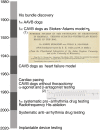The canine chronic atrioventricular block model in cardiovascular preclinical drug research
- PMID: 33684961
- PMCID: PMC9291585
- DOI: 10.1111/bph.15436
The canine chronic atrioventricular block model in cardiovascular preclinical drug research
Abstract
Ventricular cardiac arrhythmia is a life threating condition arising from abnormal functioning of many factors in concert. Animal models mirroring human electrophysiology are essential to predict and understand the rare pro- and anti-arrhythmic effects of drugs. This is very well accomplished by the canine chronic atrioventricular block (CAVB) model. Here we summarize canine models for cardiovascular research, and describe the development of the CAVB model from its beginning. Understanding of the structural, contractile and electrical remodelling processes following atrioventricular (AV) block provides insight in the many factors contributing to drug-induced arrhythmia. We also review all safety pharmacology studies, efficacy and mechanistic studies on anti-arrhythmic drugs in CAVB dogs. Finally, we compare pros and cons with other in vivo preclinical animal models. In view of the tremendous amount of data obtained over the last 100 years from the CAVB dog model, it can be considered as man's best friend in preclinical drug research. LINKED ARTICLES: This article is part of a themed issue on Preclinical Models for Cardiovascular disease research (BJP 75th Anniversary). To view the other articles in this section visit http://onlinelibrary.wiley.com/doi/10.1111/bph.v179.5/issuetoc.
Keywords: anti-arrhythmics; arrhythmia; chronic AV block dog; history; remodelling; safety pharmacology.
© 2021 The Authors. British Journal of Pharmacology published by John Wiley & Sons Ltd on behalf of British Pharmacological Society.
Conflict of interest statement
M.V. is supported by collaborations with Medtronic and Amgen. V.L. and M.v.d.H. declare no conflicts of interest.
Figures


References
-
- Alexander, S. P. H. , Mathie, A. , Peters, J. A. , Veale, E. L. , Striessnig, J. , Kelly, E. , Armstrong, J. F. , Faccenda, E. , Harding, S. D. , Pawson, A. J. , Sharman, J. L. , Southan, C. , Davies, J. A. , Aldrich, R. W. , Becirovic, E. , Biel, M. , Catterall, W. A. , Conner, A. C. , Davies, P. , … Zhu, M. (2019). The Concise Guide to PHARMACOLOGY 2019/20: Ion channels. British Journal of Pharmacology, 176(S1). 10.1111/bph.14749 - DOI - PubMed
-
- Al‐Khatib, S. M. , Stevenson, W. G. , Ackerman, M. J. , Bryant, W. J. , Callans, D. J. , Curtis, A. B. , Deal, B. J. , Dickfeld, T. , Field, M. E. , Fonarow, G. C. , Gillis, A. M. , Granger, C. B. , Hammill, S. C. , Hlatky, M. A. , Joglar, J. A. , Kay, G. N. , Matlock, D. D. , Myerburg, R. J. , & Page, R. L. (2018). 2017 AHA/ACC/HRS guideline for management of patients with ventricular arrhythmias and the prevention of sudden cardiac death: A report of the American College of Cardiology/American Heart Association Task Force on Clinical Practice Guidelines and the Heart Rhythm Society. Circulation, 138, e272–e391. 10.1161/CIR.0000000000000549 - DOI - PubMed
-
- Antoons, G. , Oros, A. , Beekman, J. D. , Engelen, M. A. , Houtman, M. J. , Belardinelli, L. , Stengl, M. , & Vos, M. A. (2010). Late Na+ current inhibition by ranolazine reduces torsades de pointes in the chronic atrioventricular block dog model. Journal of the American College of Cardiology, 55, 801–809. 10.1016/j.jacc.2009.10.033 - DOI - PubMed
-
- Arita, T. , Sorescu, G. P. , Schuler, B. T. , Schmarkey, L. S. , Merlino, J. D. , Vinten‐Johansen, J. , Leon, A. R. , Martin, R. P. , & Sorescu, D. (2007). Speckle‐tracking strain echocardiography for detecting cardiac dyssynchrony in a canine model of dyssynchrony and heart failure. American Journal of Physiology. Heart and Circulatory Physiology, 293, H735–H742. 10.1152/ajpheart.00168.2007 - DOI - PubMed
Publication types
MeSH terms
Substances
LinkOut - more resources
Full Text Sources
Other Literature Sources
Miscellaneous

